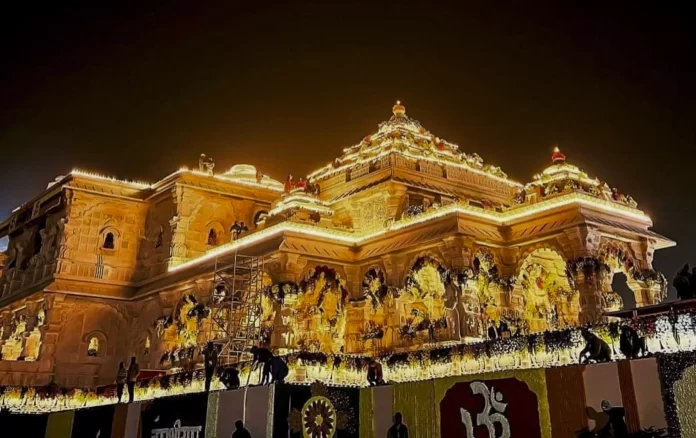The inauguration of the Ram temple in Ayodhya sparked a festive atmosphere that enveloped the nation for over a week, with many likening it to a ‘second’ Diwali. The end of a 500-year wait culminated in unprecedented celebrations nationwide
By Kanishka Sharan
The resounding chorus of “Jai Shree Ram” echoed across the nation on January 22nd, marking a pivotal moment in India’s history and transforming the lives of thousands. This historic occasion, characterized by continuous bhajans and chants of Ram ‘naam’ resonating throughout the country, captured the attention of individuals worldwide.
The inauguration of the Ram temple in Ayodhya sparked a festive atmosphere that enveloped the nation for over a week, with many likening it to a ‘second’ Diwali. The end of a 500-year wait culminated in unprecedented celebrations nationwide.
Devotees embarked on pilgrimages, traversing barefoot to the temple, their journey punctuated by chants and songs of devotion, infusing the surroundings with sanctity. The announcement of the temple’s opening spurred thousands to travel from across the country to seek the blessings of Ram Lalla, reverently regarded as the principal deity of the land.
The homecoming of Ram Lalla and its ensuing festivities extended beyond Ayodhya, resonating in cities across the homeland and even abroad. The landscape adorned itself in hues of orange, with flags fluttering atop houses and buildings, as communities united to welcome their Lord home. For some, this day bore resemblance to a day of independence.
Yet, the construction of the temple in Ayodhya, also known as ‘Ramjanmbhoomi,’ was fraught with challenges. Years of riots, upheaval, and unrest paved the path for its realization. The Babri Masjid, erected by commander Mir Baqi during Babar’s reign in 1528, became a locus of contention between Hindu and Muslim factions, with claims of a demolished temple beneath its foundations.
Amidst the jubilation surrounding the temple’s construction, questions linger regarding its underlying motives. Is it a testament to righteousness or a harbinger of Hindu supremacy? Skepticism persists among experts, pondering whether this development will resolve longstanding conflicts or sow the seeds of new discord. The answers remain elusive, awaiting the test of time
The mosque’s demolition in 1992 by a Hindu mob sparked widespread violence, leading to heightened tensions and the establishment of the Liberhan Commission to investigate the incident. Subsequent archeological surveys unearthed remnants of the ancient Hindu temple, ultimately leading the Supreme Court to authorize the temple’s construction, with alternate land allocated to the Muslim trust. In 2020, the prime minister laid the temple’s foundation stone, culminating in its completion after four years.
Many envision the temple as a catalyst for revitalizing Ayodhya and the nation, projecting it to become a premier tourist destination and driving positive economic growth.
Religion or Politics?
Amidst the jubilation surrounding the temple’s construction, questions linger regarding its underlying motives. Is it a testament to righteousness or a harbinger of Hindu supremacy? Skepticism persists among experts, pondering whether this development will resolve longstanding conflicts or sow the seeds of new discord. The answers remain elusive, awaiting the test of time.
***********************************************************************
Readers




